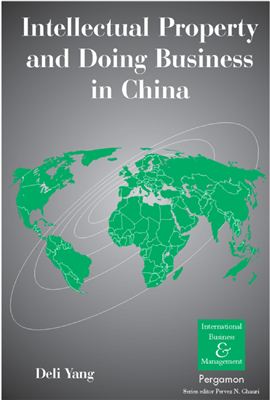Издательство Pergamon, 2003, -317 pp.
An intellectual property system was established in China in 1985. Since then, the merits and drawbacks of the system have become apparent in both theory and practice. Despite the fact that a great deal has been written about the Chinese intellectual property system, systematic studies of the subject are still scarce, especially from a corporate management perspective. The current empirical study aims to fill a void in our understanding of intellectual property in China, particularly from a corporate perspective by exploring three interlinked areas in intellectual property flows — problem detection, cause analysis, possible solutions and future thoughts. It is important to draw upon a variety of discipline approaches when exploring these issues, which are influenced by the political context, the legislative framework, economic factors
and the existence of cultural differences.
The scarcity of information on intellectual property in China also forms the fundamental motivation to publish the results of the studies to increase the awareness of the pros and cons of intellectual property system in China.
The book is intended mainly for four groups of audiences:
(1) It is a practical guide of intellectual property practices for multinational enterprises operating or working with partners in China, or with an intention of doing so in the future.
(2) It is an informative book for academics who would like to obtain information on foreign direct investment, intellectual property protection and inteational technology transfer activities in China because the book has attempted to add knowledge to the existing IP research from a corporate perspective in China.
(3) It is a reference book for govemental and inteational organisations in understanding the problems in both the intellectual property system in China and the inter-corporate relationships associated with, or arising from, intellectual property flows.
(4) It is a useful intellectual property book for Chinese companies who have business links or who intend to establish relationships with foreign companies. The book gives a good understanding of the issues of dealing with inward intellectual property flows.
Intellectual Property from a Historical Perspective
Intellectual Property Theories 3
Inteational Harmonisation of Intellectual Property
Intellectual Property System in China
Intellectual Property Activities in China
Firms and Technology in China
Critical Review of the Current Intellectual Property System in China
Corporate Intellectual Property Flows from the UK and USA into China: Problems
Corporate Intellectual Property Flows from the UK and USA into China: Causes
Corporate Intellectual Property Flows from the UK and USA into China: Possible Solutions
Conclusions: Future Challenge and Success in Cross-border Intellectual Property Flows
An intellectual property system was established in China in 1985. Since then, the merits and drawbacks of the system have become apparent in both theory and practice. Despite the fact that a great deal has been written about the Chinese intellectual property system, systematic studies of the subject are still scarce, especially from a corporate management perspective. The current empirical study aims to fill a void in our understanding of intellectual property in China, particularly from a corporate perspective by exploring three interlinked areas in intellectual property flows — problem detection, cause analysis, possible solutions and future thoughts. It is important to draw upon a variety of discipline approaches when exploring these issues, which are influenced by the political context, the legislative framework, economic factors
and the existence of cultural differences.
The scarcity of information on intellectual property in China also forms the fundamental motivation to publish the results of the studies to increase the awareness of the pros and cons of intellectual property system in China.
The book is intended mainly for four groups of audiences:
(1) It is a practical guide of intellectual property practices for multinational enterprises operating or working with partners in China, or with an intention of doing so in the future.
(2) It is an informative book for academics who would like to obtain information on foreign direct investment, intellectual property protection and inteational technology transfer activities in China because the book has attempted to add knowledge to the existing IP research from a corporate perspective in China.
(3) It is a reference book for govemental and inteational organisations in understanding the problems in both the intellectual property system in China and the inter-corporate relationships associated with, or arising from, intellectual property flows.
(4) It is a useful intellectual property book for Chinese companies who have business links or who intend to establish relationships with foreign companies. The book gives a good understanding of the issues of dealing with inward intellectual property flows.
Intellectual Property from a Historical Perspective
Intellectual Property Theories 3
Inteational Harmonisation of Intellectual Property
Intellectual Property System in China
Intellectual Property Activities in China
Firms and Technology in China
Critical Review of the Current Intellectual Property System in China
Corporate Intellectual Property Flows from the UK and USA into China: Problems
Corporate Intellectual Property Flows from the UK and USA into China: Causes
Corporate Intellectual Property Flows from the UK and USA into China: Possible Solutions
Conclusions: Future Challenge and Success in Cross-border Intellectual Property Flows

